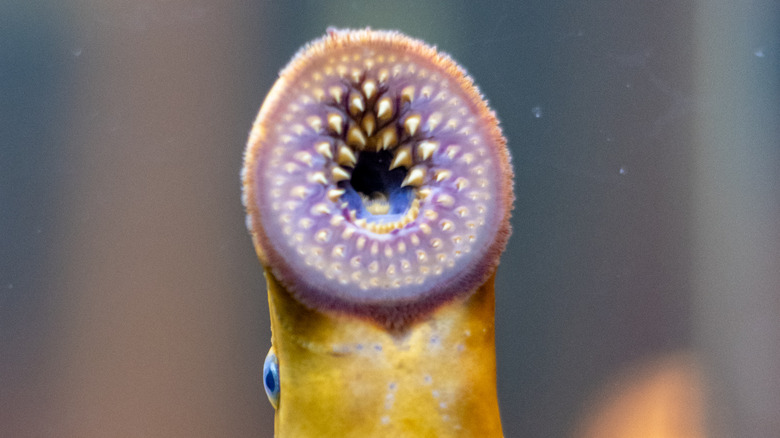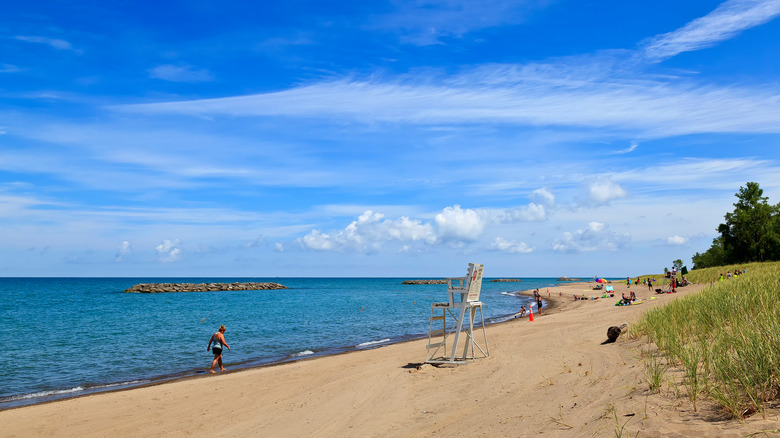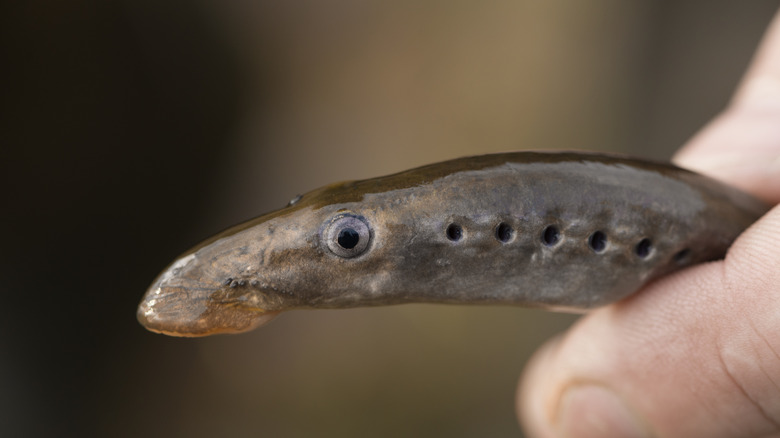The Scary Creatures Making An Unfortunate Comeback In These Popular US Lakes
The legend of the Lake Erie monster Bessie is a staple of Ohio and Michigan folklore that's freaky enough to send a chill up your spine. However, the real, tangible threat to the Great Lakes actually comes in the form of a small, bloodsucking creature: Sea lampreys are terrifying-looking creatures making a comeback in the Great Lakes.
Greg McClinchey, the legislative affairs and policy director for the Great Lakes Fishery Commission, told The Wall Street Journal that sea lampreys are "unquestionably the stuff of nightmares." Sea lampreys — which received the accurate moniker "vampire fish" — are parasitic fish resembling eels that grow anywhere between 14 to 24 inches in length. Instead of the regular mouth you'd see on most fish, sea lampreys have a disk-shaped mouth filled with rows of tiny teeth and a razor-sharp tongue. With these horn-shaped teeth, they attach and burrow themselves into the skin of other fish to consume blood and bodily fluids. Yes, it's as gross as it sounds.
While sea lampreys are native to the Atlantic Ocean, they are a highly invasive species in the Great Lakes. Their population has increased and declined in the lakes since first being recorded in the 1800s. That said, the presence of sea lampreys in the Great Lakes surged during the height of the COVID-19 pandemic, because travel restrictions hindered population control efforts. If you are visiting the Great Lakes, there are a few things you should know about these vampiric fish.
The harm sea lampreys cause in the Great Lakes
Contrary to what the 2014 horror film, "Blood Lake: Attack of the Killer Lampreys" suggests, sea lampreys pose no danger to humans, and they are not attracted to warm-blooded beings. So, it is perfectly safe for vacationers to take a dip in the Great Lakes despite the rising sea lamprey presence. The Great Lakes' often unpredictable conditions that increase the risk of drowning pose the biggest danger to people.
The biggest cause of concern surrounding sea lampreys is what they do to the environment. Unfortunately, a majority of fish species native to this beautiful area are at risk of being attacked and killed by the parasitic invaders. "They either kill the fish or leave it severely compromised," Christina Carter of the Great Lakes Fishery Commission told the Milwaukee Journal Sentinel. "If you are a trout or salmon, you definitely don't want to have a sea lamprey in your life."
Since sea lampreys are invasive and have no natural predators in the Great Lakes, they wreak havoc on underwater habitats. A single sea lamprey can eat up to 40 pounds of fish during a 12-month period, and females can lay up to 100,000 eggs before they die. Shockingly, a whopping 100 million pounds of Great Lakes fish are killed each year by these vampiric creatures. Due to their lack of a natural predator and voracious appetites, sea lampreys have caused a dramatic decrease in fish populations in the past.
Do sea lampreys deserve their bad reputation?
To curb the sea lamprey infestation in the Great Lakes, the Great Lakes Fishery Commission runs a control program. The main method used is the release of lampricides — pesticides that specifically impact lampreys — to kill larvae. Traps and tributary barriers are also used to catch adult sea lampreys.
All that said, sea lampreys are actually a keystone species in their natural Atlantic Ocean environment; meaning, without them, many marine ecosystems would be at risk of collapsing. They are commonly on the menu for animals such as turtles, minks, otters, and numerous species of birds, like herons and eagles. Unfortunately, factors like ocean pollution and habitat loss have left sea lamprey populations threatened in many areas of the Atlantic and Pacific oceans. The bottom line? These aquatic animals are undeniably creepy looking and can cause massive harm to native species in the Great Lakes. On the flip side, sea lampreys shouldn't just be cast aside as underwater monsters, especially when they play a crucial role in their natural environment.


